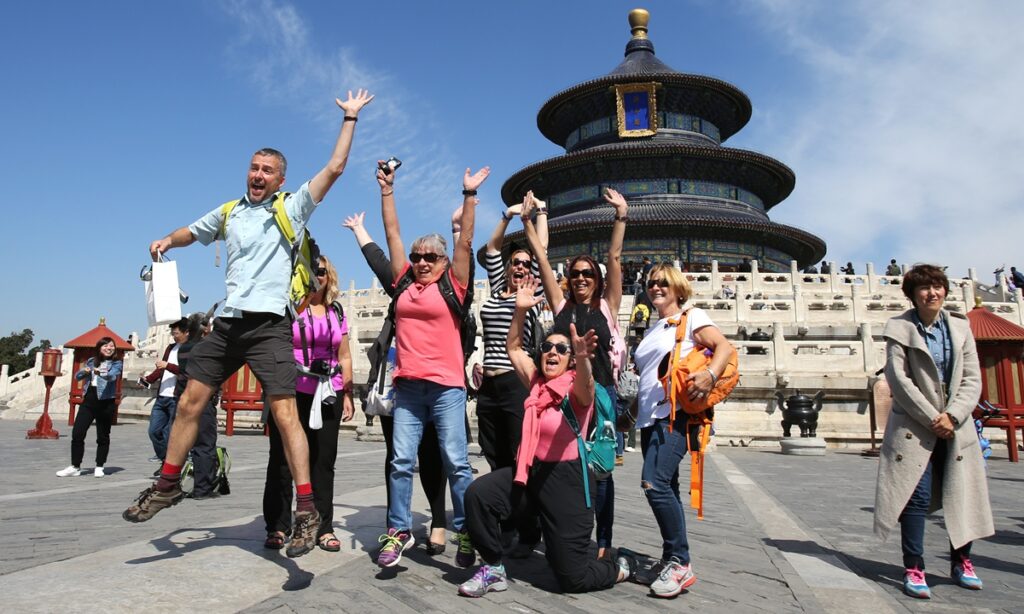The National Immigration Administration recently released data showing that in the first half of this year, 14.635 million foreign nationals entered China through various ports, an increase of 152.7 percent year-on-year. This growth is largely attributed to a series of policies introduced by China to promote high-level opening-up and attract foreigners, particularly the visa-free policies. The data reveals that 8.542 million foreigners entered China visa-free, marking a year-on-year increase of 190.1 percent.
The introduction of the “72/144-hour visa-free transit” policy has made it increasingly convenient for foreign tourists to visit China, allowing them the opportunity to spend 72 hours, 144 hours, or even longer to experience the real China. They can explore China’s profound history and culture, its dazzling modern achievements, delicious cuisine, beautiful landscapes and the friendliness of the Chinese people. Their experiences, shared through various travel videos tagged with “China Travel” on global social media, have garnered up to 1 billion views, spreading to unimaginable corners of the world. This phenomenon showcases China’s high-quality development and high-level opening-up and has sparked a wave of interest in visiting China internationally.
A simple comparison highlights the booming inbound tourism market in China. Data from an online travel service platform shows that in the first half of this year, the number of bookings for domestic flights in China by travelers using non-Chinese passports increased by 1.8 times compared to 2023. This absolute growth in numbers reflects the effectiveness of a series of convenience measures taken by China to improve the quality and efficiency of inbound tourism services, and enhance the travel experience for foreigners. Currently, the “72/144-hour visa-free transit” policy and the high-quality travel experience are becoming new hallmarks of contemporary China.
The more than 8 million foreigners who entered China without a visa in the first half of the year are the witnesses and narrators of the real China. Any rumors or smears against China, no matter how carefully constructed or repeatedly hyped up, are easily debunked in the face of such a massive and spontaneous dissemination. China’s high efficiency in administration and governance is fully reflected in the rapid and precise measures taken to address the “bottlenecks” for foreign tourists. China is too big and 144 hours are too short. According to relevant platforms, over 10 percent of foreign tourists have visited China more than twice in the past six months, which shows that China’s efforts and truth have brought in real “repeat visitors.”
From the “72/144-hour visa-free transit” to “City or not City” becoming a popular internet meme, and now with the continuous rise in popularity of “China Travel,” it is clear that the world is eagerly seeking to understand a more comprehensive and real China, and China is welcoming this enthusiasm and expectation with a more open attitude. The reason why “China Travel” has been widely praised worldwide is the inevitable result of the systematic development of cultural and tourism, cultural and technological deep integration represented by “smart tourism” in China in recent years. The construction and digital upgrade of cultural and tourism infrastructure provide a solid foundation for China Travel.
At the same time, contemporary Chinese experiences represented by “China Travel” are stepping out of the country and facing the world. In May of this year, the “Hello, China” exhibition area made its debut at the 31st Arabian Travel Market in Dubai, the UAE, showcasing the latest convenient policies and services for inbound tourism in China, as well as new cultural entertainment products such as Hanfu (a traditional Chinese-style of clothing) shows and immersive interactive experiences. This attracted the attention of global travel merchants and audiences. Furthermore, from relatively traditional variety shows and dramas to micro-dramas and script entertainment, the all-round matrix-style development of China’s cultural industry is generating a wide range of international communication effects, attracting more old partners and new friends from around the world to repeatedly come to China, experience China, deepen their understanding and recognition of China.
From a deeper perspective, as some countries are adopting protectionist and anti-globalization policies, China continues to introduce policies to facilitate the entry of foreigners into China, demonstrating with its own strategic determination and commitment to opening-up that open cooperation is still the trend of history, mutual benefit and win-win cooperation is still the aspiration of all people. When videos filmed by foreign bloggers who set foot on Chinese soil as soon as the visa-free policy was implemented generate wider interest and a strong urge to visit China, a virtuous cycle of mutual benefit between China and the world magically emerges. With just a mobile phone and a backpack, any traveler can become a discoverer and witness of China’s charm. An open China is always here, welcoming all friends who want to come and see.
Global Times




